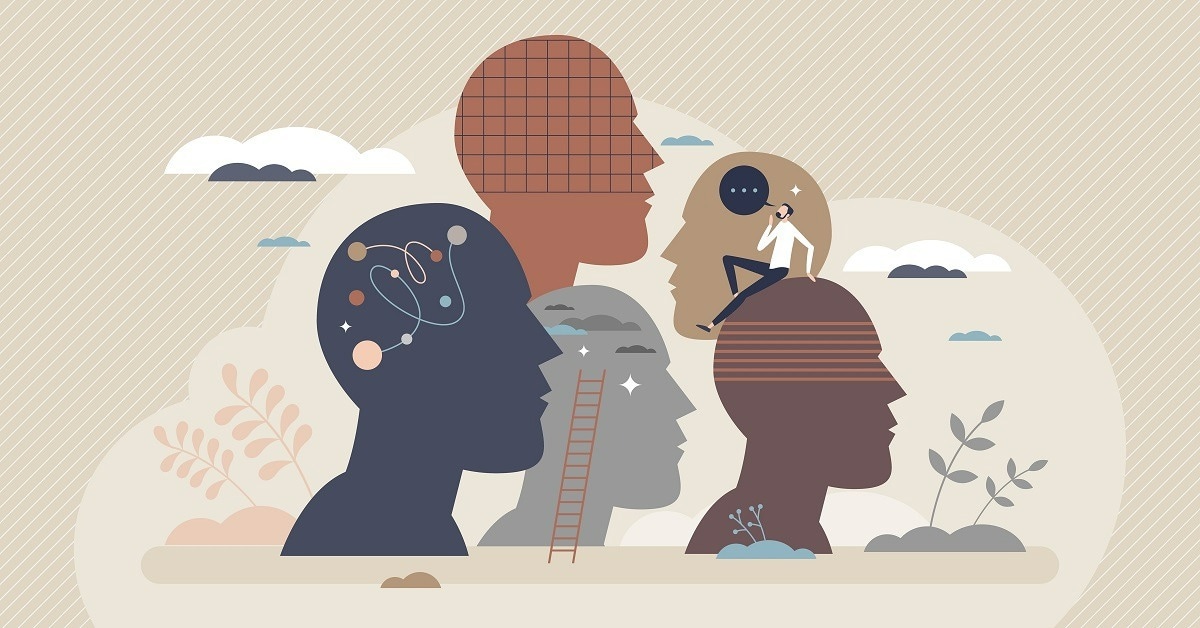Areas of neurodiversity in healthcare
Healthcare workers
Patients
Conclusion
References
Further reading
Recent thinking is that there is no ‘normal’ for the human brain or the human thought processes. Despite the numerous diagnostic criteria for mental illness and psychiatric disorders, some philosophers postulate that common disorders like autism spectrum disorder (ASD), attention deficit hyperactivity disorder (ADHD), intellectual disability (ID), and dyslexia, as well as affective and behavioral disorders, are often overdiagnosed. That is the exact degree of deviance from the standard set up by scientists at which human behavior becomes ‘abnormal’ is yet to be defined.

Image Credit: VectorMine/Shutterstock.com
One reason for this type of thinking is the observation that many people with mental or emotional disorders have strengths. For instance, autistic individuals find language processing and social interactions hard. Still, they can do mathematical feats, identify complex patterns in great detail or do excellent work with computer languages and machines. Most people with ASD have higher nonverbal intelligence scores compared to verbal skills.
Given this striking association, ASD individuals on the ASD spectrum are now often preferred by many companies for dealing with tasks like writing computer manuals, database management, or identifying bugs in software.
Similar unusual skills have been described with dyslexia, like identifying ‘impossible objects’ or processing blurred pictures more efficiently than non-dyslexic peers. This is valuable in various fields, such as molecular biology, engineering, and computer graphics.
IDs like Down syndrome and Williams syndrome are associated with warm and outgoing personalities or musical abilities. Similarly, ADHD is associated with creativity and an adventurous spirit.
It is possible to assign specific roles of value to each of these traits in earlier societies, explaining why they were positively selected. For instance, ADHD traits could have promoted tool making, identifying hunting trails through exploring the environment, quickly recognizing and escaping or fending off danger, and finding food sources and safe places to stay in.
It is wise to recognize that people engage with the world and each other in many ways, drawing conclusions and using different modes of learning and thinking. These differences complement each other, offering a richer and fuller perspective on life.
Therefore, neurodiversity should be assigned a due value in designing healthcare systems. An approach to the neurodiverse in healthcare based on recognizing strengths will go far in understanding the true worth of such individuals, treating them with respect and dignity, and providing opportunities for them to enrich the field of healthcare by playing to their strengths.
Areas of neurodiversity in healthcare
The healthcare community can improve its approach to neurodiversity concerning the healthcare workforce and patient care.
Healthcare workers
The majority of neurodiverse people are unemployed. This may reflect a lack of communication skills, harmful behavior, or dependence on caregivers for daily activities.
Stigmas associated with neurodiversity can block such people from seeking employment appropriate to their strengths and skills, as can the absence of awareness that these people can contribute significantly at work.
Overlooking neurodiverse people in the employment pool could harm the healthcare field, which runs on people with autism-like traits, including perfectionism, intense tenacity of purpose, loyalty, and honesty. Moreover, employing neurodiverse physicians and healthcare workers could help neurodiverse patients feel understood and better satisfied with their care.
It is important to focus on ameliorating the challenges faced by neurodiverse people rather than ‘curing’ the underlying diversity of neurologic function. Support should be available for all who need and want it so that they can enjoy the best possible quality of life in their situation and use their potential to benefit society and themselves while achieving their personal goals.

Image Credit: DisobeyArt/Shutterstock.com
This may involve changes in how staff structures and spaces in an office are designed in the workplace. For instance, ASD individuals may not tolerate sudden or loud sounds due to their increased sensory acuity. This may require setting up a quiet place for breaks, warning them about loud sounds ahead of time, and allowing noise-canceling headphones.
Similarly, people with ADHD should be allowed to fidget, move about more frequently, and change their position often, as long as they are productive in the workplace and contributing adequately to the work team’s output.
Again, clear communication styles should be used without sarcastic or veiled messages. Implied meanings should be avoided, and clear, concise instructions should be used to break down tasks, preferably written. Since ASD people tolerate change poorly, they should be prepared for upcoming changes of plan and informed about the reason for the alteration.
Such individuals may also need training in appropriate workplace behavior, while their colleagues should be helped to recognize that much apparent rudeness or insubordinate behavior is simply misunderstanding social rules.
At the same time, such training should not insist on stopping behavior (like fidgeting) that helps such individuals to calm down, nor should they be forced to engage with others beyond their coping capacity. Such masking reactions, which compensate for perceived differences in oneself compared to others by imitating their behavior, may, if severe, induce a negative mood.
Patients
A neurodiversity approach to patients in healthcare involves designing rooms and spaces that engage attention without overwhelming it. These should be friendly, inviting, and reassuring spaces that convey a sense of individual value to the patient while avoiding clutter. Clear pathways and lines of sight at the level of children and access to the outdoors and to pets are important contributors to such spaces.
Some special adjustments for neurodiverse patients include avoiding automated equipment that moves suddenly or operates loudly. Automatic flush toilets can be scary for such patients, as may automatic doors or paging systems.
Rooms with low stimulation levels, dimmable lighting, and temperature settings are also comfortable for these patients, especially if they can safely enclose themselves in their own space with movable lightweight furniture. Larger, stronger beds would allow parents to lie close to anxious or overwrought children. Children hypersensitive to external stimuli should be able to retreat from active play areas to quieter, calmer areas.

Image Credit: LightField Studios/Shutterstock.com
Again, technology could come to the rescue by avoiding the need to give the same personal and medical information repeatedly while waiting to see healthcare providers – frequently a source of anxiety to such patients.
Healthcare should focus on how the caregiver can change to help the child feel comfortable and safe rather than focusing on one-sided interventions to change the child.
Warmth, a positive strengths-based rather than deficit-based approach, and hopefulness when discussing the needs of such individuals that must be addressed are key aspects of healthcare for such children. Such a supportive and accepting atmosphere should add a big competitive advantage to healthcare facilities, attracting staff and clientele.
Conclusion
Some scientists say that we should “replace a “disability” or “illness” paradigm with a “diversity” perspective that takes into account both strengths and weaknesses.” As discussed above, opening healthcare workplace opportunities to neurodiverse people with special skills benefits everyone.
Moreover, creating an atmosphere of concern that caters to neurodiverse employees and patients as to everyone else is bound to spread throughout the organization, helping streamline processes and improve management practices.
The practice of neurodiversity in healthcare, therefore, brings benefits all down the line, as attested by many organizations that have adopted this approach.
At the same time, other scientists caution that recognizing neurodiversity should not mean accepting or promoting the view that mental illness does not exist. This is because some disorders, like depression or schizophrenia, are potentially disabling or fatal and need to be diagnosed and treated promptly to prevent such outcomes.
References
- Armstrong, T. (2015). The Myth of the Normal Brain: Embracing Neurodiversity. AMA Journal of Ethics. DOI: DOI 10.1001/journalofethics.2015.17.4.msoc1-1504. Retrieved from https://journalofethics.ama-assn.org/article/myth-normal-brain-embracing-neurodiversity/2015-04. Accessed on September 28, 2022.
- Broder-Fingert, S. et al. (2022). Embracing Neurodiversity in Our Health Systems. Retrieved from https://www.aap.org/en/news-room/aap-voices/embracing-neurodiversity-in-our-health-systems/. Accessed on September 28, 2022.
- Baumer, N. et al. (2022). What is neurodiversity? Retrieved from https://www.health.harvard.edu/blog/what-is-neurodiversity-202111232645. Accessed on September 28, 2022.
- Marberry, S. (2021). Designing for Neurodiversity in Healthcare Environments. Retrieved from https://www.saramarberry.com/designing-for-neurodiversity-healthcare-environments/. Accessed on September 28, 2022.
- Nerenberg, J. et al. (2017). Why Neurodiversity Matters in Health Care. Retrieved from https://www.aspeninstitute.org/blog-posts/neurodiversity-matters-health-care/. Accessed on September 28, 2022.
- Duong, D. et al. (2022). Untapped potential: embracing neurodiversity in medicine. CMAJ. DOI: https://doi.org/10.1503/cmaj.1096006. https://www.cmaj.ca/content/194/27/E951
- Ruffalo, M. (2018). Neurodiversity: A Dangerous Extension of a Discredited Philosophy. Available at https://www.psychotherapy.net/blog/title/neurodiversity-a-dangerous-extension-of-a-discredited-philosophy. Accessed on October 3, 2022.
- Brown, H. M. et al. (2021). Changing the story: How diagnosticians can support a neurodiversity perspective from the start. SAGE journals. Doi: https://doi.org/10.1177/13623613211001012. https://journals.sagepub.com/doi/10.1177/13623613211001012
- Poltronieri, L. et al. (2022). Designing for Neurodiversity in Pediatric Healthcare Spaces. Available at https://www.hok.com/ideas/publications/designing-for-neurodiversity-in-pediatric-healthcare-spaces/. Accessed on October 3, 2022.
- Bailin, A. (2019). Clearing Up Some Misconceptions about Neurodiversity. Scientific American. Available at https://blogs.scientificamerican.com/observations/clearing-up-some-misconceptions-about-neurodiversity/. Accessed on October 3, 2022.
- Bruyere, S. (2019). Editorial: The advantages and challenges of neurodiversity employment in organizations. Journal of Management and Organization. DOI: doi:10.1017/jmo.2019.58. Advantages and challenges of neurodiversity employment in organizations
Further Reading
- All Healthcare Content
- Role of Real-Time Data in Healthcare
- Healthcare Systems Around the World
- What is the Role of Regulatory Bodies in Healthcare?
- How is the ‘omics’ Revolution Changing Healthcare?
Last Updated: Jan 10, 2023

Written by
Dr. Liji Thomas
Dr. Liji Thomas is an OB-GYN, who graduated from the Government Medical College, University of Calicut, Kerala, in 2001. Liji practiced as a full-time consultant in obstetrics/gynecology in a private hospital for a few years following her graduation. She has counseled hundreds of patients facing issues from pregnancy-related problems and infertility, and has been in charge of over 2,000 deliveries, striving always to achieve a normal delivery rather than operative.
Source: Read Full Article
